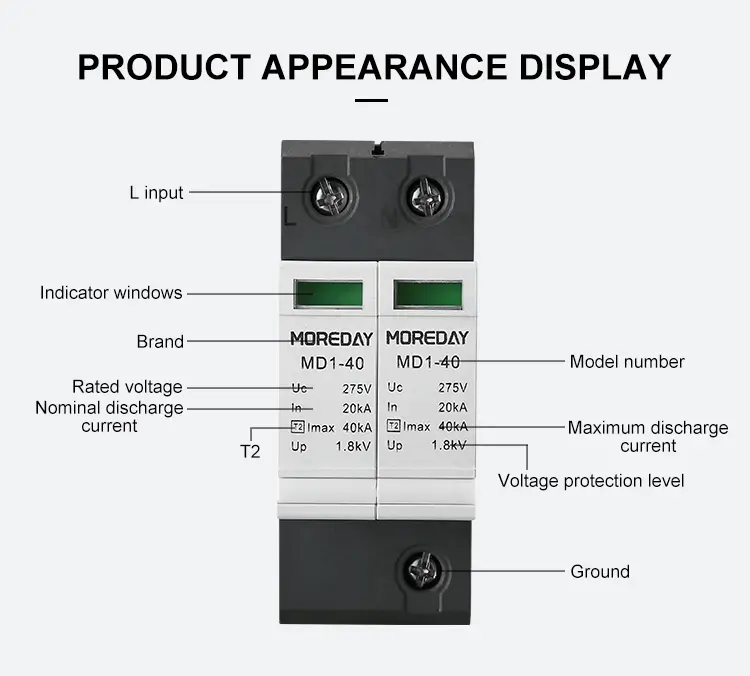Yes, a surge protector can protect against lightning to a certain extent, but its main purpose is to protect electrical equipment from transient voltages, such as power surges caused by lightning. A surge protector prevents damage to electrical equipment by directing excessive voltage to the ground.
However, it does not completely prevent lightning strikes from hitting electrical wiring or buildings directly. For complete lightning protection, a more comprehensive protection such as a combination of lightning rods and grounding systems is usually required.
This article will take an in-depth look at how a surge protector works, whether or not it has lightning protection, and how it can effectively protect electrical equipment from the dual threat of lightning strikes and power surges.
What Is a Surge Protector?

Before discussing surge protectors, it is first necessary to understand what a surge is. A surge is a sudden increase in voltage over a short time, usually lasting from a few tens of microseconds to a few milliseconds. Surges are usually caused by several things:
- Lightning strikes: Lightning strikes may initiate direct or indirect voltage surges, resulting in instantaneous high currents through the circuit.
- Power equipment switching operations: Voltage fluctuations and current surges can be triggered when high-power electrical equipment is started up or shut down.
- Grid faults: Short circuits or other faults in the grid can also cause instantaneous voltage fluctuations.
These rapid changes in voltage can cause irreversible damage to household appliances and electronic equipment, and surge protectors are designed to cope with this situation.
How Surge Protectors Work
The working principle of surge protectors is mainly to protect equipment by limiting overvoltage to an acceptable range or directing excess current to the ground when the voltage exceeds a safe threshold. Surge protectors are usually composed of components such as metal oxide varistors (MOVs) or gas discharge tubes (GDTs). These components conduct when the voltage is abnormally high, dissipating or diverting the surge energy, thereby preventing the surge from damaging the equipment.
The working mechanism of MOV: MOV is in a high impedance state under normal voltage, and current cannot pass through. When the voltage exceeds a certain value, the resistance of the MOV will drop rapidly, allowing a large amount of current to pass through and be directed to the ground, thus weakening the impact of the surgeon on the equipment.
Common Applications of Surge Protectors
Surge protectors are commonly used to protect sensitive electronic equipment such as:
- Computers
- Home theater systems
- Household appliances (e.g. refrigerators, washing machines, etc.)
- Network equipment such as servers, routers, etc.
Typically, surge protectors are integrated into plugs and sockets, or can be installed separately on the electrical system’s distribution boards to provide more comprehensive protection.
Do Surge Protectors Protect Against Lightning?

Yes, a surge protector protects against lightning to a certain extent, but not completely against direct damage from a lightning strike. It is mainly used to prevent surges caused by lightning strikes or other causes, especially secondary surges that are conducted to the power system after a long-distance lightning fall. The following is a specific analysis:
The Relationship Between Lightning Strikes and Surges
Lightning strikes are indeed a major cause of power surges, especially during thunderstorms, when lightning may enter a building through power lines, telephone lines, or other conductive media, resulting in transient high voltages that can cause damage to equipment. As a result, many people mistakenly believe that installing a surge protector will protect them from lightning.
However, the surge generated by lightning is far beyond the capacity of the general electrical equipment, transient voltage may reach millions of volts, while the ordinary surge protector is designed for smaller amplitude voltage changes, such as by the power equipment switch, short-circuit, etc. caused by the surge.
Surge Protectors Have Limited Lightning Protection Capabilities
Although the surge protector can effectively deal with secondary surges caused by lightning strikes (i.e., surges conducted through the power system after lightning lands over long distances), it is unable to directly protect against the enormous energy of a single lightning strike. Simply put, a surge protector can only partially mitigate the threat of lightning-induced surges, but it cannot completely prevent direct damage to buildings or equipment from lightning strikes.
How to Effectively Protect Against Lightning?
Since surge protectors cannot completely protect against lightning, how do you achieve effective lightning protection? An effective lightning protection system needs to combine a variety of protective measures.
1. External Lightning Protection Measures
The purpose of external lightning protection measures is to prevent lightning from directly hitting the building or surrounding equipment. Common external lightning protection measures include:
- lightning rods: lightning rods avoid direct lightning strikes on buildings or their equipment by introducing lightning into the ground.
- grounding system: an effective grounding system ensures that lightning currents are quickly directed into the earth and reduces the spread of current through the building or power system, thereby reducing the risk of equipment damage.
2. Internal Protection Measures
The external protection system can lead the lightning strike energy to the ground, but the surge caused by the lightning strike may still be conducted through the power lines and other ways to the building. Therefore, internal protective measures are equally important.
- Multi-stage surge protectors: Internal protection systems can gradually reduce surge energy by installing multi-stage surge protectors. The first stage of the surge protector is installed on the distribution board, responsible for weakening the majority of the surge from the grid; the second stage is installed near the equipment to further mitigate the residual surge.
- Disconnection protection: In the event of a thunderstorm, disconnecting unnecessary electrical equipment on time can dramatically reduce the risk of lightning-induced damage. Some intelligent circuit breakers can even automatically disconnect power when an abnormal voltage is detected.
3. Regular Inspection and Maintenance
To ensure the effectiveness of lightning protection measures, regular inspection and maintenance is very important. For example:
- Check whether the connection between the lightning rod and the grounding system is firm.
- Check the status of the surge protector, some surge protectors will lose their protective ability after suffering many surge impacts and need to be replaced periodically.
Surge Protector Selection and Installation Recommendations

Although a surge protector does not provide direct lightning protection, it is still an important part of protecting electronic equipment in a multi-level protection system. Selecting and installing a suitable surge protector can greatly improve the safety of electrical equipment.
1. Choose According to Equipment Requirements
Different surge protectors have different rated voltages and current capacities. You can choose the appropriate model according to the equipment you need to protect. For high-value equipment such as servers and home entertainment systems, it is recommended to choose a high-specification surge protector. MOREDAY provides a wide range of surge protectors, and you can also consult them for help
For example, the current capacity of a server is usually between 10-30 amps, while a home entertainment system may require a 5-15 amp surge protector. Choosing a surge protector with a protection level of 3 or above is recommended, which can withstand transient voltages of more than 6000 volts to ensure the safety of high-value equipment.
2. Importance of Installation Location
The installation location of the surge protector directly affects its protection effect. Typically, surge protectors should be located as close as possible to the electrical panel or outlet, and should be well connected to the grounding system.
Studies have shown that the closer the surge protector is to the equipment, the better the protection effect. It is recommended to install it near the power distribution board or outlet and make sure the grounding resistance is less than 10 ohms.
3. Combined Lightning and Surge Protectors
For optimal protection, it is recommended to install both a lightning protector and a surge protector. Lightning arresters are responsible for dealing with the direct impact of lightning strikes, while surge protectors are used to weaken the surge caused by lightning strikes and protect precision equipment.
Data shows that using a combination of lightning arrestors and surge protectors in a lightning protection system can reduce the risk of damage from lightning strikes by 70-80%.
Conclusion
To summarize, a surge protector can cope with surges triggered by lightning strikes to a certain extent, but it does not completely prevent lightning strikes from damaging equipment. To achieve effective lightning protection, combining external lightning protection devices, grounding systems, internal surge protectors, and other protective measures is necessary.
At the same time, selecting suitable surge protectors and regular inspection and maintenance are also key steps to ensure the safety of the equipment.
Through scientific and reasonable protection system design, users can greatly reduce the risk of damage to electrical equipment from lightning strikes and surges, ensuring the safe operation of equipment in thunderstorms.
Related reading: Types of surge protection devices


